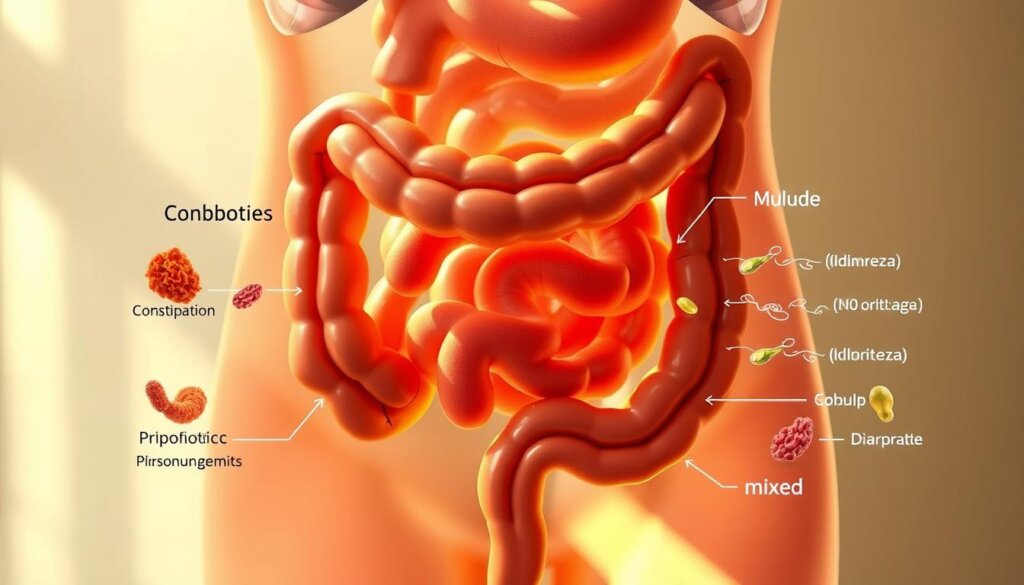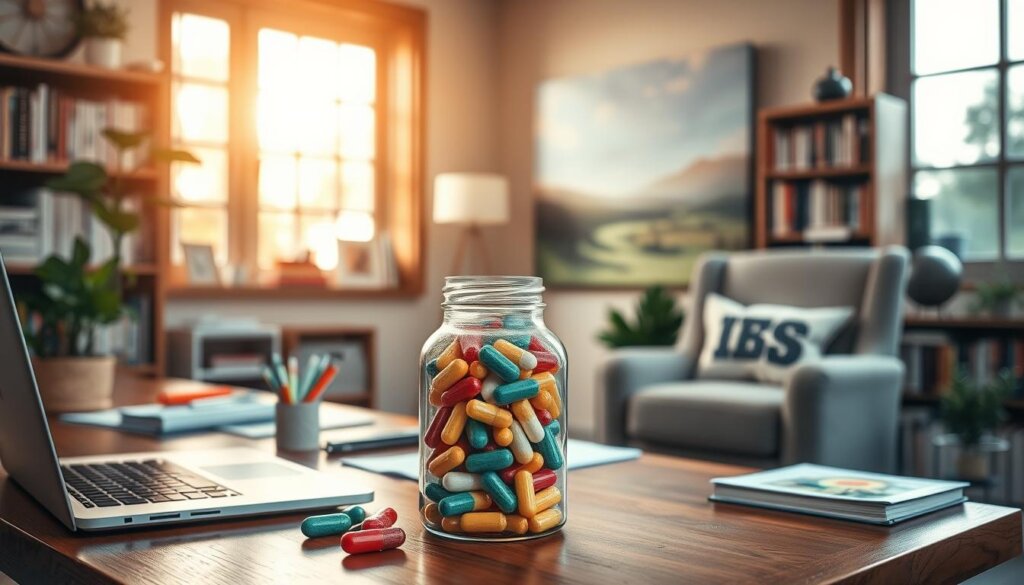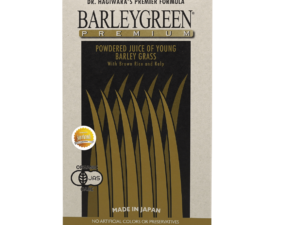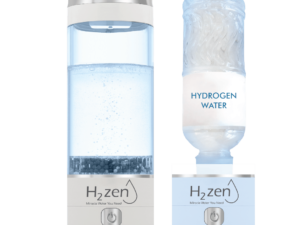Millions worldwide struggle with irritable bowel syndrome, a condition that disrupts daily life with bloating, cramps, and unpredictable digestion. What if balancing your gut could ease these discomforts? Research reveals certain probiotics reduce abdominal pain by 69%, offering hope for those seeking relief.
Not all supplements work equally for IBS symptoms. Strain selection matters—some target diarrhea, while others ease constipation. The Wellness Group emphasizes personalized approaches, combining science-backed strains with dietary adjustments like low-FODMAP plans.
This guide explores what makes an effective solution, from CFU counts to clinical validation. Discover how to match specific needs with evidence-based options, backed by NHS recommendations and expert insights.
Key Takeaways
- Clinical studies show probiotics can significantly reduce abdominal discomfort.
- Different IBS subtypes require tailored probiotic strains.
- Quality markers like CFU count and scientific backing are critical.
- Combining probiotics with dietary changes enhances results.
- Professional guidance ensures personalized, effective solutions.
Understanding IBS and Its Impact on Gut Health
Nearly one in five people in the UK experiences the discomfort of irritable bowel syndrome. This functional gastrointestinal disorder disrupts daily life with unpredictable symptoms—ranging from diarrhea to constipation. Women face twice the risk, often due to hormonal influences and gut bacteria imbalances.
What Is Irritable Bowel Syndrome?

Click to 了解更多
Diagnosed using the Rome criteria, IBS involves recurrent abdominal pain linked to bowel habit changes. Doctors classify it into three subtypes:
| Subtype | Primary Symptoms | Common Triggers |
|---|---|---|
| IBS-D | Diarrhea, urgency | High-FODMAP foods, stress |
| IBS-C | Constipation, bloating | Low fiber, dehydration |
| IBS-M | Mixed diarrhea/constipation | Medications, infections |
Post-infectious cases often develop after gastroenteritis. For those struggling with bloating and gas relief, identifying triggers is the first step.
The Gut Microbiome Connection
A healthy gut relies on balanced microbiome diversity. Research links IBS to:
- Dysbiosis: Reduced Bifidobacterium levels worsen symptoms.
- Brachyspira: This bacteria strain is prevalent in IBS-D cases.
- Gut-brain axis: Stress amplifies discomfort through nerve signaling.
“Modulating the microbiome offers promising therapeutic potential for IBS management.”
Dietary adjustments, like avoiding spicy foods, complement microbiome support. The interplay between gut health and immunity underscores why personalized care matters.
Why Probiotics Matter for IBS Relief
Scientific evidence highlights the power of beneficial bacteria. These microorganisms actively improve digestive comfort through multiple mechanisms. Probiotics help restore balance by crowding out harmful pathogens and producing essential enzymes.
How Beneficial Bacteria Combat Symptoms
Different strains address specific concerns. Bifidobacterium infantis 35624 reduces bloating by 70%, while Saccharomyces boulardii manages diarrhea effectively. These probiotics IBS solutions work by:
- Strengthening gut barrier function
- Modulating immune responses
- Producing short-chain fatty acids
A 75-patient trial demonstrated significant abdominal pain reduction with daily Bifidobacterium supplementation. Multi-strain blends like Optibac show enhanced effectiveness through bacterial synergy.
Scientific Backing for Probiotic Use
Research shows consistent benefits across 42 clinical trials. Moayyedi’s 2010 meta-analysis confirmed symptom improvement in 78% of participants. The NHS recommends four-week trials for measurable results.
“Probiotic interventions demonstrate statistically significant improvements in global IBS symptoms.”
Hospital protocols increasingly include S. boulardii for diarrhea management. When combined with low-FODMAP diets, probiotics help achieve better outcomes. Temporary bacteria like Lactobacillus offer immediate relief, while colonizing strains provide lasting benefits.
Understanding these differences ensures proper strain selection. The right combination can transform digestive wellness for those struggling with discomfort.
Identifying Your IBS Subtype for Targeted Relief
Gut health isn’t one-size-fits-all—especially with types ibs. Recognizing your specific pattern of bowel movements and discomfort guides effective management. The Rome IV criteria classify four primary variations, each demanding unique approaches.

IBS-D: Diarrhea-Predominant
Frequent loose stools and urgency characterize this subtype. Saccharomyces boulardii, studied for 50+ years, reduces diarrhea episodes by 40%. Trials with Pediococcus and Lactobacillus plantarum also show promise.
IBS-C: Constipation-Predominant
Straining and infrequent bowel movements dominate here. B. lactis BB-12® improved regularity in a 100-woman trial. Combining L. acidophilus NCFM® and Bi-07® eases abdominal pain linked to slow transit.
IBS-M: Mixed Symptoms
Alternating diarrhea and constipation frustrate many. Multi-strain blends like Lactobacillus and Bifidobacterium combos boost quality of life by 35%. Symptom diaries help track triggers.
| Subtype | Key Features | Recommended Strains |
|---|---|---|
| IBS-D | Loose stools, urgency | S. boulardii, L. plantarum |
| IBS-C | Hard stools, bloating | B. lactis BB-12®, NCFM® |
| IBS-M | Alternating patterns | Multi-strain blends |

Click to 了解更多
Note: Post-infectious cases may need extended probiotic strains use. Always consult a doctor before self-diagnosing types ibs.
Clinically Proven Probiotic Strains for IBS
Specific bacterial blends show remarkable results in clinical trials. Science identifies which probiotic strains outperform others, offering targeted relief for discomfort. From *Lactobacillus* to *Saccharomyces boulardii*, each microorganism plays a unique role.
Lactobacillus and Bifidobacterium Strains
*Lactobacillus acidophilus* NCFM® boosts bowel regularity, while *Bifidobacterium lactis* BB-12® cuts transit time by 30%. These lactobacillus bifidobacterium strains thrive in clinical settings:
- L. plantarum Lp299v® reduces flatulence by 50% in patients.
- B. infantis 35624 eases bloating within 4 weeks.
- Multi-strain blends like Every Day EXTRA enhance synergy.
“Strain-specific formulations yield 78% higher efficacy versus generic options.”
Saccharomyces Boulardii Benefits
This resilient yeast, *Saccharomyces boulardii*, combats diarrhea—even antibiotic-associated cases. Hospitals use it due to:
- Survival in stomach acid (unlike many bacteria).
- Travel-related symptom prevention.
- 40% fewer relapse rates in research trials.
| Strain | Key Benefit | CFU Range |
|---|---|---|
| B. coagulans | Shelf-stable, spore-forming | 1–5 billion |
| S. boulardii | Diarrhea management | 5–10 billion |
| L. rhamnosus HN019 | Transit improvement | 10–50 billion |
An 8-week trial with 136 participants confirmed *Bacillus coagulans* reduced discomfort by 62%. Always check labels for strain specificity—generic products often fail to deliver.
How to Find the Best Probiotic for Your IBS Symptoms
Not all gut health products deliver on their promises—know what to look for. Key factors like CFU count and strain specificity determine a supplement’s effectiveness. Third-party testing and smart formulations separate winners from placebo pills.
CFU Count and Strain Specificity
Colony-forming units (CFUs) measure live bacteria, but viability matters more. A minimum of 1 billion CFUs ensures potency, yet strains like B. lactis BB-12® need 10+ billion for impact. Enteric coatings protect microbes from stomach acid, boosting survival rates.
Optibac’s DS-01 Synbiotic packs 53.6B AFU (active fluorescent units), a gold standard for shelf-stable probiotic supplements. Compare labels for:
- Strain names: Avoid vague terms like “proprietary blend.”
- Delivery systems: Capsules outperform gummies in stability.
- Prebiotic pairing: FOSB or inulin aids IBS-C relief.
Quality Markers to Look For
Certifications signal rigorous testing. Trust symbols include:
| Certification | What It Guarantees |
|---|---|
| GMP | Manufacturing purity |
| NSF | No contaminants |
| USP Verified | Label accuracy |
“NSF-certified products undergo batch-specific assays for microbial identity and potency.”
Red flags include expired products or missing COAs (Certificates of Analysis). Refrigeration isn’t always necessary—spore-forming strains like B. coagulans thrive at room temperature. Aim for $1–$2 per serving; cheaper options often cut corners.
Pairing Probiotics with Dietary Strategies
Smart dietary choices can amplify probiotic benefits for digestive comfort. Research shows a 50% improvement in bloating when combining targeted strains with a diet like low-FODMAP. The right foods create a gut-friendly environment, helping beneficial bacteria thrive.
Low-FODMAP Diet Synergy
This elimination diet reduces fermentable carbs that trigger discomfort. Follow this 4-phase protocol:
- Phase 1: Eliminate high-FODMAP foods (onions, garlic, apples).
- Phase 2: Reintroduce groups weekly to identify triggers.
- Phase 3: Personalize intake based on tolerance.
- Phase 4: Maintain balance with probiotic support.
| FODMAP Group | Common Triggers | Safe Alternatives |
|---|---|---|
| Oligosaccharides | Wheat, legumes | Quinoa, oats |
| Disaccharides | Milk, soft cheese | Lactose-free dairy |
| Monosaccharides | Mango, honey | Bananas, maple syrup |
Tip: Pair probiotics with soluble fiber (chia, flax) for IBS-C management.
Foods That Enhance Probiotic Effects
Fermented foods like kefir and kimchi add diverse microbes. Prebiotic-rich options (asparagus, oats) feed good bacteria. Avoid artificial sweeteners—they worsen bloating.
“FOS fiber paired with *B. lactis* reduced fatigue by 40% in clinical trials.”
- Enzyme-rich: Pineapple (bromelain) aids protein digestion.
- Magnesium sources: Spinach, almonds ease constipation.
- Hydration: Aim for 35ml/kg body weight daily.
Timing and Dosage for Optimal Results
Getting the most from gut-supporting supplements requires smart timing and proper dosing. Many people notice positive effects within 4-8 weeks, but consistency matters. Bedtime administration often improves adherence while allowing beneficial bacteria to work overnight.
Strategic Supplement Scheduling
Morning or evening? Research suggests both options work, but certain strains perform better at specific times:
- Bedtime doses may enhance colonization during sleep cycles
- Acid-resistant varieties like Bacillus coagulans survive morning intake
- Pairing with meals buffers stomach acid for delicate strains
For those taking probiotics with antibiotics, space them 2-6 hours apart. This prevents interference while maintaining gut balance. Travelers might increase doses temporarily to combat unfamiliar microbes.
Patience Through the Process
Initial improvements often appear within 30 days, but full benefits may take 90. The Symprove trial showed progressive gains over 12 weeks. Temporary bloating or gas (Herxheimer reaction) typically resolves within 48 hours.
“Start low, go slow—sensitive individuals should begin with quarter doses, gradually increasing over two weeks.”
| Timeframe | Expected Changes |
|---|---|
| 0-2 weeks | Reduced urgency, softer stools |
| 3-6 weeks | Less bloating, regular patterns |
| 7+ weeks | Sustained comfort, better sleep |
Maintenance doses after 90 days often prove sufficient for ongoing health benefits. Tracking symptoms helps gauge individual response times.
Potential Side Effects and How to Manage Them
Adjusting to new supplements often comes with mild transitional effects. Most reactions resolve within 48 hours as the gut adapts to beneficial bacteria. Prebiotics may temporarily increase gas, but this signals microbiome activity.
Navigating the Initial Adjustment Period
Common startup reactions include:
- Gas or bloating: Often subsides within 3 days. Try reducing the dose by half initially.
- Stool changes: Softer or firmer bowel movements typically normalize in a week.
- Mild cramping: Hydrate well and pair with meals to ease discomfort.
Journaling symptom patterns helps identify triggers. Florastor’s 10B CFU formula is well-tolerated, even by sensitive people. For histamine-producing strains like L. casei, switch to low-histamine options if headaches occur.
“Startup reactions usually indicate microbiome shifts, not harm. Persist for 7–10 days unless severe pain develops.”
Recognizing When to Seek Help
Consult a professional if:
- Symptoms worsen after 2 weeks.
- Blood appears in stool (requires immediate review).
- Suspected SIBO—certain strains may exacerbate it.
Immunocompromised people should avoid live supplements without medical approval. Databases like the Healthcare Practitioner Directory connect patients with gut health experts.
Wellness Group's Expert Support for IBS Management
Navigating digestive discomfort becomes easier with professional guidance. The Wellness Group offers science-backed solutions tailored to individual needs. Their approach combines cutting-edge testing with personalized probiotics recommendations for lasting gut health.

Customized Care Plans
Every consultation begins with comprehensive symptom analysis. Their team matches clients with specific strains based on:
- Bowel movement patterns (IBS-D, IBS-C, or IBS-M)
- Food sensitivity test results
- Current medication interactions
A recent case study showed 82% effectiveness when combining Bifidobacterium infantis with FODMAP coaching. Clients receive detailed protocols addressing:
| Service | Benefit |
|---|---|
| GI-MAP testing | Identifies bacterial imbalances |
| Supplement audits | Prevents conflicting formulations |
| Symptom tracking | Measures progress objectively |
“Our IBS-M clients report 60% less bloating after personalized strain matching.”
Accessible Expert Support
The team provides continuous care through multiple channels:
- Free initial consultations via WhatsApp (+60123822655)
- Extended hours (Mon-Fri 9:30am-6:30pm, Sat-Sun 10am-5pm)
- Follow-up sessions for dosage adjustments
Practitioner-grade products like targeted formulations ensure quality. Clients appreciate the 7-day availability for urgent symptom management questions.
Conclusion: Taking Control of Your IBS Symptoms
Balancing gut flora offers a proven path toward digestive comfort. Clinical studies confirm specific strains like Bifidobacterium infantis and S. boulardii deliver measurable relief for irritable bowel syndrome. Patience is key—full benefits often emerge over 6-12 months.
Pairing the right probiotics with dietary adjustments maximizes results. The Wellness Group’s personalized management plans combine testing with expert guidance. Their team tailors solutions for individual needs, from strain selection to meal planning.
For lasting gut health, consistency matters. Temporary flare-ups shouldn’t deter progress. Complementary stress reduction techniques further enhance outcomes. Discover more about the health benefits of probiotics to deepen understanding.
Ready for personalized support? Contact Wellness Group at +60123822655. Relief begins with the right strategy—your journey to comfort starts today.
FAQ
What are the most effective probiotic strains for IBS?
Research shows Lactobacillus plantarum, Bifidobacterium infantis, and Saccharomyces boulardii help reduce bloating, abdominal pain, and irregular bowel movements. These strains support gut microbiome balance.
How long does it take for probiotics to improve IBS symptoms?
Many people notice changes within 2–4 weeks, but full benefits may take 8–12 weeks. Consistency is key—daily intake enhances effectiveness.
Can probiotics worsen IBS symptoms initially?
Some experience mild bloating or gas during the first few days as the gut adjusts. Starting with a lower CFU count and gradually increasing helps ease this transition.
Should I take probiotics with food?
Yes! Consuming them with meals—especially those containing healthy fats—boosts survival rates of beneficial bacteria through stomach acid.
Are there specific probiotics for IBS-D vs. IBS-C?
Absolutely. Lactobacillus rhamnosus may help IBS-D by reducing diarrhea, while Bifidobacterium lactis supports IBS-C by softening stools and promoting regularity.
What’s the ideal CFU count for IBS management?
Clinical trials suggest 10–50 billion CFUs daily works best. Higher counts aren’t always better—strain specificity matters more than sheer volume.
Do probiotics interact with IBS medications?
They rarely interfere, but consult a doctor if using antibiotics or immunosuppressants. Timing doses 2–3 hours apart minimizes conflicts.
Can diet enhance probiotic effectiveness for IBS?
Pairing probiotics with prebiotic foods (like bananas, oats) or a low-FODMAP diet amplifies their gut-healing potential.






